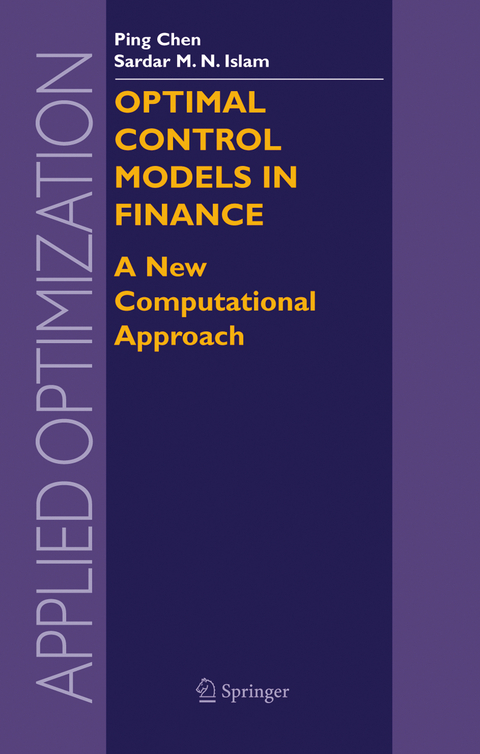
Optimal Control Models in Finance
A New Computational Approach
Seiten
2004
Springer-Verlag New York Inc.
978-0-387-23569-1 (ISBN)
Springer-Verlag New York Inc.
978-0-387-23569-1 (ISBN)
This book reports initial efforts in providing some useful extensions in - nancial modeling; The demonstrated extensions in this book in the computation and modeling of optimal control in finance have shown the need and potential for further areas of study in financial modeling.
This book reports initial efforts in providing some useful extensions in - nancial modeling; further work is necessary to complete the research agenda. The demonstrated extensions in this book in the computation and modeling of optimal control in finance have shown the need and potential for further areas of study in financial modeling. Potentials are in both the mathematical structure and computational aspects of dynamic optimization. There are needs for more organized and coordinated computational approaches. These ext- sions will make dynamic financial optimization models relatively more stable for applications to academic and practical exercises in the areas of financial optimization, forecasting, planning and optimal social choice. This book will be useful to graduate students and academics in finance, mathematical economics, operations research and computer science. Prof- sional practitioners in the above areas will find the book interesting and inf- mative. The authors thank Professor B.D. Craven for providing extensive guidance and assistance in undertaking this research. This work owes significantly to him, which will be evident throughout the whole book. The differential eq- tion solver “nqq” used in this book was first developed by Professor Craven. Editorial assistance provided by Matthew Clarke, Margarita Kumnick and Tom Lun is also highly appreciated. Ping Chen also wants to thank her parents for their constant support and love during the past four years.
This book reports initial efforts in providing some useful extensions in - nancial modeling; further work is necessary to complete the research agenda. The demonstrated extensions in this book in the computation and modeling of optimal control in finance have shown the need and potential for further areas of study in financial modeling. Potentials are in both the mathematical structure and computational aspects of dynamic optimization. There are needs for more organized and coordinated computational approaches. These ext- sions will make dynamic financial optimization models relatively more stable for applications to academic and practical exercises in the areas of financial optimization, forecasting, planning and optimal social choice. This book will be useful to graduate students and academics in finance, mathematical economics, operations research and computer science. Prof- sional practitioners in the above areas will find the book interesting and inf- mative. The authors thank Professor B.D. Craven for providing extensive guidance and assistance in undertaking this research. This work owes significantly to him, which will be evident throughout the whole book. The differential eq- tion solver “nqq” used in this book was first developed by Professor Craven. Editorial assistance provided by Matthew Clarke, Margarita Kumnick and Tom Lun is also highly appreciated. Ping Chen also wants to thank her parents for their constant support and love during the past four years.
Optimal Control Models in Finance.- The STV Approach to Financial Optimal Control Models.- A Financial Oscillator Model.- An Optimal Corporate Financing Model.- Further Computational Experiments and Results.- Conclusion.
| Reihe/Serie | Applied Optimization ; 95 |
|---|---|
| Zusatzinfo | XVIII, 201 p. |
| Verlagsort | New York, NY |
| Sprache | englisch |
| Maße | 155 x 235 mm |
| Themenwelt | Mathematik / Informatik ► Mathematik ► Analysis |
| Mathematik / Informatik ► Mathematik ► Angewandte Mathematik | |
| Mathematik / Informatik ► Mathematik ► Finanz- / Wirtschaftsmathematik | |
| Wirtschaft ► Betriebswirtschaft / Management ► Finanzierung | |
| Schlagworte | Finanzmathematik |
| ISBN-10 | 0-387-23569-8 / 0387235698 |
| ISBN-13 | 978-0-387-23569-1 / 9780387235691 |
| Zustand | Neuware |
| Haben Sie eine Frage zum Produkt? |
Mehr entdecken
aus dem Bereich
aus dem Bereich
Band 5: Hydraulik, Stromfadentheorie, Wellentheorie, Gasdynamik
Buch | Softcover (2024)
De Gruyter Oldenbourg (Verlag)
CHF 83,90


